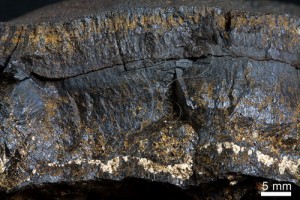|

Introduction
Manganese Nodules were first obtained by the British research vessel, the HMS Challenger, during her global marine research expedition from 1873 to 1876 and at the waters around the Canary Islands off the northwestern shores of Africa. It is a nucleated material with a core made out of matters such as clay, skeletal remains of organisms, volcanic matters and some minerals. The core is then surrounded by layers of metal precipitations from seawaters or sediments, containing minerals such as iron, manganese, cobalt, nickel, copper and other rare elements. They are generally distributed on deep sea plains or under sea mountain ridges at the depth of 3,000 to 4,000 meters. These Manganese Nodules contain abundant metallic alloys important to industries, making them potentially valuable mining resources of great economical interests.
Morphology
Manganese Nodules usually vary greatly in their sizes; generally, they appear spherical in shapes, their diameters vary from 2 to 5 cm, with larger nodules measuring no bigger than 25 cm. Their colors are between black and yellowish-brown, mostly appear dirt black; nodules with high iron contents may appear reddish brown, while those that contain manganese are bluish black in color. These Manganese Nodules are porous and fragile, and have an onion-layer like structures as one of their characteristic features. Their density is usually between 2 to 3 g/cm3.
Occurrence
Manganese Nodules are widely distributed on the ocean floors of the 3 major oceans of the world, with Pacific Ocean having the most concentrations and widest distributions. They are mostly distributed in the ocean depths between 3,000 and 4,000 meters, few are found in shallow regions such as mid-ocean ridges, seamounts and continental slopes. For example, Manganese Nodules have been found in shallow waters (300m) of the southeastern United States’ Blake Ridge submarine plateau. Surveys have showed that these Manganese Nodules usually formed on the surfaces deep sea sediments with low sedimentation rate (<0.5 cm per thousand year) and good oxidation conditions. However, once they have been buried, their growths are stopped completely.
Mineral compositions
The cores of Manganese Nodules are composed of minerals such as quartz, feldspar, olivine, pyroxene, zeolite and clay. The outer layers are formed by manganese minerals such as Todorokite and Birnessite, and iron hydroxide minerals such as hydrogoethite and hematite.
Chemical properties
The most abundant metallic components in a nodule is manganese, followed by iron, nickel, cobalt, copper, aluminum, molybdenum, vanadium and titanium. The contents of each element vary in the regions they are found in, even within the same area. The differences in metallic contents seem to be associated with the compositions of local volcanic activities.
Theories of formation
Researchers have found that these Manganese Nodules grow at an extremely slow rate, often growing only 0.1 to 0.4 cm in a million year. The exact formation of these Manganese Nodules are not yet fully understood, partly because most of them are only found in the depths of oceans, and lack of deep sea data precluded researchers on forming a conclusive hypothesis. Some of the current theories include:
(1) Hydrogenous: precipitations from seawater
(2) Hydrothermal: precipitations from the extremely hot water produced by deep sea volcanic hot springs.
(3) Debris weathering: weathering and decomposition of debris from deep sea igneous rocks such as basalt.
(4) Diagenetic: the remobilization of manganese from the sediments and settle on the interface between water and sediments.
Main purpose
Manganese Nodules is a metallic aggregate that may contain abundant elements such as manganese, iron, cobalt, nickel, copper, lead, molybdenum, vanadium and titanium. The manganese content in these Manganese Nodules may reach as high as 18%. Since most of these elements are important sources of alloys and metals for modern industries, these Manganese Nodules are viewed as valuable mineral resources of great economical potential. However, since most of these Manganese Nodules are located in deep sea beds, salvaging them in great numbers are difficult and costly; in addition, there still exist problems in smelting these Manganese Nodules, therefore no large scale excavations of these minerals have been made yet.
Sedimentary rocks – Biochemical and chemical sedimentary rocks
The international digital archives and e-learning communication project of the National Museum of Natural Science
National Museum of Natural Science
|